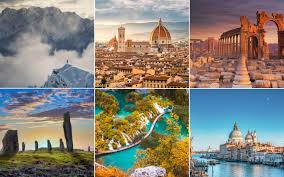The Beauty and Significance of UNESCO World Heritage Sites
UNESCO World Heritage Sites are exceptional places around the globe that have been recognized for their cultural, historical, scientific, or natural significance. These sites are considered to be of outstanding universal value and are protected for future generations to appreciate and enjoy. From ancient ruins to stunning natural landscapes, UNESCO World Heritage Sites offer a glimpse into the rich tapestry of human history and the wonders of the natural world.
Preserving Cultural Heritage
Many UNESCO World Heritage Sites are renowned for their cultural importance. These sites include iconic landmarks such as the Pyramids of Egypt, the Great Wall of China, and the Acropolis in Greece. By preserving these sites, UNESCO aims to safeguard our shared cultural heritage and promote cross-cultural understanding and appreciation.
Celebrating Natural Wonders
In addition to cultural sites, UNESCO also designates natural wonders as World Heritage Sites. These include breathtaking landscapes like the Grand Canyon in the United States, the Great Barrier Reef in Australia, and Serengeti National Park in Tanzania. These sites showcase the beauty and diversity of our planet’s natural environment and highlight the importance of conservation efforts to protect them for future generations.
Challenges and Conservation
While being recognized as a UNESCO World Heritage Site brings prestige and protection, many sites also face challenges such as over-tourism, climate change, and inadequate preservation efforts. Conservation organizations work tirelessly to address these issues and ensure that these sites remain intact for years to come.
An Invitation to Explore
Visiting a UNESCO World Heritage Site is not just a journey through time or nature—it’s an opportunity to connect with our collective past and appreciate the beauty of our planet. Whether you’re exploring ancient ruins or hiking through pristine wilderness, each site offers a unique experience that will leave a lasting impression on your heart and mind.
As we continue to cherish and protect these extraordinary places, let us remember that they are not just monuments or landscapes—they are testaments to our shared humanity and our responsibility to preserve them for future generations.
7 Essential Tips for Visiting and Preserving UNESCO World Heritage Sites
- Research the history and significance of the UNESCO World Heritage Site you plan to visit.
- Follow all rules and regulations set by the site management to help preserve its integrity.
- Respect the local culture, traditions, and customs when visiting a World Heritage Site.
- Take only photographs and leave only footprints to minimize your impact on the site.
- Support sustainable tourism practices by choosing eco-friendly transportation options.
- Engage with local guides or experts to gain a deeper understanding of the site’s importance.
- Spread awareness about UNESCO World Heritage Sites and their preservation through social media or word-of-mouth.
Research the history and significance of the UNESCO World Heritage Site you plan to visit.
Before embarking on a journey to a UNESCO World Heritage Site, it is essential to delve into the history and significance of the site you intend to visit. Researching the background and cultural importance of the UNESCO World Heritage Site not only enhances your understanding and appreciation of the place but also enriches your overall experience. By learning about the historical context, architectural marvels, or natural wonders that make up the site, you can truly immerse yourself in its beauty and significance, gaining a deeper connection to the rich heritage preserved within its boundaries.
Follow all rules and regulations set by the site management to help preserve its integrity.
It is crucial to follow all rules and regulations set by the site management when visiting UNESCO World Heritage Sites to help preserve their integrity. These guidelines are put in place to protect these exceptional places and ensure that they can be enjoyed by future generations. By respecting the rules, visitors contribute to the conservation efforts that aim to maintain the authenticity and significance of these sites, allowing them to continue serving as valuable cultural and natural treasures for years to come.
Respect the local culture, traditions, and customs when visiting a World Heritage Site.
When visiting a UNESCO World Heritage Site, it is essential to respect the local culture, traditions, and customs of the community that calls the site home. By honoring and embracing these aspects, visitors can deepen their understanding of the site’s significance and forge meaningful connections with the people who have preserved it for generations. Respecting local culture not only enriches the travel experience but also contributes to the preservation of these invaluable sites for future generations to appreciate and cherish.
Take only photographs and leave only footprints to minimize your impact on the site.
When visiting UNESCO World Heritage Sites, it is essential to adhere to the principle of “Take only photographs and leave only footprints” to minimize your impact on these precious locations. By refraining from taking souvenirs or leaving behind any traces of your visit, you help preserve the site’s integrity and protect it for future generations to enjoy. This simple yet powerful guideline promotes responsible tourism and ensures that these significant cultural and natural wonders remain unspoiled for years to come.
Support sustainable tourism practices by choosing eco-friendly transportation options.
Supporting sustainable tourism practices by choosing eco-friendly transportation options is a crucial step in preserving the integrity and beauty of UNESCO World Heritage Sites. By opting for modes of transportation that have a lower environmental impact, such as public transit, cycling, or electric vehicles, visitors can reduce their carbon footprint and help mitigate the effects of climate change on these precious locations. Making conscious choices about how we travel to and around these sites not only benefits the environment but also contributes to the long-term sustainability of these cultural and natural wonders for generations to come.
Engage with local guides or experts to gain a deeper understanding of the site’s importance.
Engaging with local guides or experts while visiting UNESCO World Heritage Sites can enrich your experience and provide valuable insights into the site’s significance. These knowledgeable individuals can offer unique perspectives, historical context, and cultural anecdotes that enhance your understanding and appreciation of the site. By interacting with local guides, you not only gain a deeper understanding of the site’s importance but also support the local community and contribute to sustainable tourism practices. Embrace the opportunity to connect with these experts and let them illuminate the wonders of UNESCO World Heritage Sites in a truly meaningful way.
Spread awareness about UNESCO World Heritage Sites and their preservation through social media or word-of-mouth.
Spreading awareness about UNESCO World Heritage Sites and the importance of their preservation is crucial in ensuring these cultural and natural treasures are protected for future generations. By utilizing social media platforms or engaging in word-of-mouth conversations, individuals can educate others about the significance of these sites and inspire a sense of responsibility towards their conservation. Sharing captivating photos, interesting facts, and personal experiences related to UNESCO World Heritage Sites can spark curiosity and encourage others to appreciate and support efforts to safeguard these invaluable legacies. Together, we can raise awareness and foster a global commitment to preserving these iconic landmarks and natural wonders for the benefit of all.




